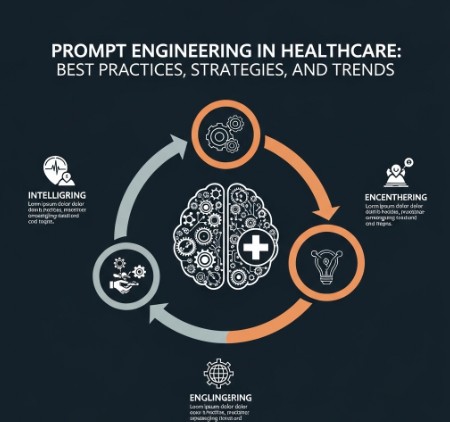The healthcare industry is undergoing a significant transformation driven by advancements in artificial intelligence (AI), particularly in the realm of large language models (LLMs). Harnessing the power of these LLMs effectively, however, requires a deep understanding of prompt engineering. This article delves into the critical aspects of Prompt Engineering Healthcare, exploring best practices, effective strategies, and emerging trends to help professionals in the field leverage this technology for improved patient care, research, and administrative efficiency. We’ll explore how carefully crafted prompts can unlock the full potential of AI in a sensitive and regulated environment like healthcare.
Table of Contents
- 1 Understanding Prompt Engineering in a Healthcare Context
- 2 Best Practices for Prompt Engineering in Healthcare
- 3 Advanced Strategies in Prompt Engineering Healthcare
- 4 Prompt Engineering Healthcare: Ethical Considerations
- 5 Frequently Asked Questions
- 5.1 What are the potential risks of poorly designed prompts in healthcare AI?
- 5.2 How can I ensure the privacy and security of patient data when using prompt engineering?
- 5.3 What are the future trends in prompt engineering for healthcare?
- 5.4 How can I learn more about prompt engineering in healthcare?
- 6 Conclusion
Understanding Prompt Engineering in a Healthcare Context
Prompt engineering, in its essence, is the art and science of designing effective prompts to elicit desired responses from LLMs. In healthcare, this translates to crafting precise instructions that guide AI systems to generate accurate diagnoses, create personalized treatment plans, analyze medical images, or streamline administrative tasks. The quality of the prompt directly impacts the quality and reliability of the AI’s output. Poorly constructed prompts can lead to inaccurate or misleading results, potentially jeopardizing patient safety. Therefore, mastering Prompt Engineering Healthcare is paramount.
Key Considerations for Healthcare Prompts
- Data Privacy and Security: Prompts should never reveal Protected Health Information (PHI) unless strictly necessary and within a secure environment compliant with HIPAA and other relevant regulations.
- Ambiguity Avoidance: Clear, concise, and unambiguous prompts are crucial. Avoid jargon and ensure the prompt’s intent is easily understood by the AI.
- Contextual Awareness: Provide sufficient context to the AI. Include relevant patient history, medical records, and other pertinent information.
- Bias Mitigation: Carefully design prompts to minimize bias and ensure equitable outcomes for all patients, regardless of race, gender, or socioeconomic status.
Best Practices for Prompt Engineering in Healthcare
Developing effective prompts for healthcare applications requires a structured approach. Following best practices ensures accuracy, reliability, and ethical considerations are upheld.
Iterative Prompt Refinement
The process of crafting the perfect prompt is rarely a one-time event. It often involves iterative refinement, testing different variations, and analyzing the results. Start with a simple prompt and gradually increase complexity as you understand the model’s behavior and limitations. Use A/B testing to compare different prompt variations.
Specificity and Constraints
Instead of broad, general prompts, focus on specific tasks and desired outcomes. Clearly define constraints, limitations, and acceptable formats for the output. For instance, instead of asking “Analyze this patient’s condition,” provide a more specific prompt like: “Analyze the patient’s symptoms, medical history, and lab results provided below, and generate a differential diagnosis in a structured format including ICD-10 codes and a probability score for each diagnosis.”
Few-Shot Learning and Examples
Incorporating a few examples in the prompt (few-shot learning) can significantly improve the AI’s understanding and performance. This is particularly helpful when dealing with complex medical scenarios or specialized terminology.
Advanced Strategies in Prompt Engineering Healthcare
As the sophistication of LLMs increases, so do the opportunities for advanced prompt engineering techniques in healthcare. These techniques allow for greater control and customization of the AI’s response.
Chain-of-Thought Prompting
This technique involves prompting the AI to explicitly outline its reasoning process before generating a final answer. This increases transparency and allows for easier identification of errors or biases in the AI’s logic. For example, instead of simply asking for a diagnosis, ask the AI to detail its reasoning step-by-step: “Analyze the patient data. First, list the key symptoms. Second, identify potential differential diagnoses based on these symptoms. Third, list the most likely diagnosis based on probability and supporting evidence. Finally, provide a concise summary of your reasoning.”
Prompt Chaining
Breaking down complex tasks into a series of smaller, interconnected prompts can enhance the accuracy and efficiency of the AI’s response. Each prompt builds upon the previous one, refining the results at each stage.
Prompt Tuning and Fine-tuning
For highly specialized tasks, fine-tuning the LLM on a relevant healthcare dataset can significantly improve its performance. This process involves adapting the model’s weights and parameters to the specific needs of the healthcare application. Prompt tuning is a less resource-intensive alternative, involving optimizing the prompts themselves to achieve similar results.
Prompt Engineering Healthcare: Ethical Considerations
The ethical implications of using AI in healthcare cannot be overstated. Prompt Engineering Healthcare must be conducted responsibly and ethically. Bias mitigation strategies are paramount. Ensuring transparency, accountability, and human oversight in the decision-making process is crucial to maintain patient safety and trust.
Frequently Asked Questions
What are the potential risks of poorly designed prompts in healthcare AI?
Poorly designed prompts can lead to inaccurate diagnoses, inappropriate treatment recommendations, and privacy breaches. The consequences can range from minor inconveniences to serious harm for patients.
How can I ensure the privacy and security of patient data when using prompt engineering?
Always use anonymized or de-identified data whenever possible. Adhere strictly to HIPAA and other relevant regulations concerning data privacy and security. Utilize secure computing environments and access control mechanisms.
What are the future trends in prompt engineering for healthcare?
Future trends include the increased use of multimodal prompts (incorporating text, images, and other data types), personalized prompts tailored to individual patients, and the development of automated prompt generation tools.
How can I learn more about prompt engineering in healthcare?
Several online resources, including research papers, tutorials, and online courses, offer valuable information on prompt engineering techniques and best practices. Look for courses and materials specifically targeting healthcare applications.

Conclusion
Mastering Prompt Engineering Healthcare is essential for unlocking the full potential of AI in the healthcare industry. By following best practices, employing advanced strategies, and prioritizing ethical considerations, healthcare professionals can leverage the power of LLMs to improve patient care, accelerate research, and streamline operations. Remember that continuous learning and iterative refinement are key to achieving optimal results and ensuring the responsible and ethical application of AI in healthcare. The future of healthcare is inextricably linked to the effective and ethical application of AI, and Prompt Engineering Healthcare will play a pivotal role in shaping this future. Thank you for reading the DevopsRoles page!
Further reading: Ethical Considerations for AI in Healthcare Large Language Models for Healthcare
